
Bristol's Seals, Arms and Logos (1)
Seals
Seals were introduced as a way of authenticating documents. A blob of soft sealing wax was melted and the seal, often in the form of a signet ring, pressed into it. Seals have been in use for a long time and there is a mention of them being misused in the Bible's Old Testament, 1 Kings 21:8 in King James version says...
So she [Jezebel] wrote letters in Ahab's name, and sealed them with his seal, and sent the letters unto the elders and to the nobles that were in his city, dwelling with Naboth.
The first known seal used by the City of Bristol was issued early in the reign of King Edward I who reigned from 1272 to 1307.
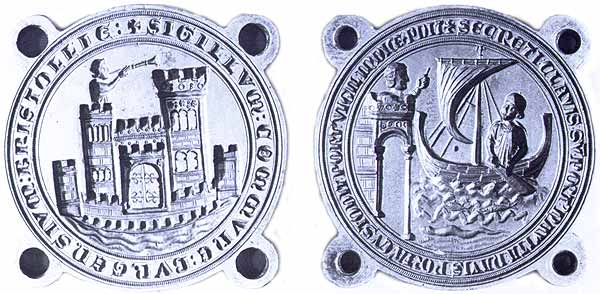
The first seal of Bristol
Image from "Civic Treasures of Bristol" by Mary E. Williams, published by City of Bristol, 1984
This seal has two halves that were aligned using the lugs seen on the above image. It was used not only on official city of Bristol documents but was used by city burgesses whose seals were not sufficiently well-known. A burgess was originally any freeman of a particular borough but was later redefined as any city official either elected or not.
One side of the seal shows the castle, which was built between 1130 and 1150, including the great keep on which a watchman stands with a trumpet. The reverse shows a ship approaching the castle watergate along the Avon which teems with fish and eels. Ships at that time were steered using a broad board over the side of the ship and not with a rudder at the stern. A watchman points out the entrance to the watergate.
The text on this side of the seal reads "Secreti clavis sum portus. Navita navis Portam custodit. Portum vigil indice prodit." A translation of this is "I am the key of the hidden port. The sailor watches the port side of the ship. The watchman points out the port with his finger", an alternative translation is "I am the key of the secret port. The pilot steers the helm of the ship. The warder points out the port with his fore-finger."
This seal is the only one that I have seen where the ship is entering the castle watergate, all seals after this show the ship leaving the watergate. This seal was in use until 1569 when Bristol was granted a crest with supporters - the golden unicorns - for the civic arms.
There was another seal apparently also issued in the reign of Edward I and that now shows the ship leaving the castle...
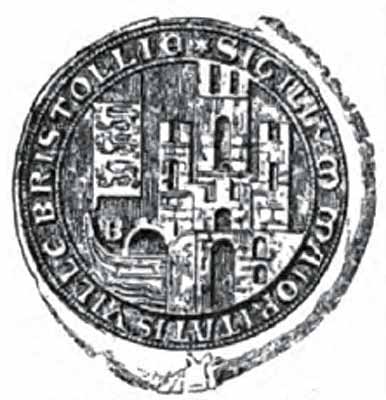
City seal from the the reign of Edward I
Image from "Bristol Past and Present" by James Fawckner Nicholls and John Taylor, published by J. W. Arrowsmith, 1881
The text reads "Sigillum Maioritatis Ville Bristolie."
Another seal was issued during the reign of Edward III in 1359...
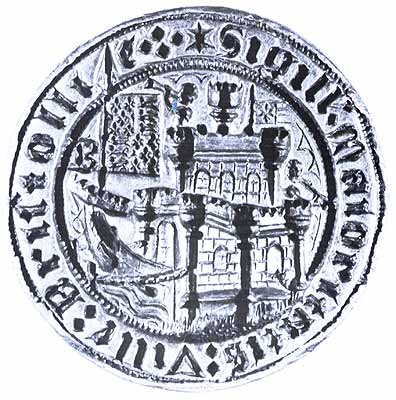
Second mayoral seal - 1359
Image from "Civic Treasures of Bristol" by Mary E. Williams, published by City of Bristol, 1984
This seal replaced an earlier seal that was produced earlier in Edward III's reign. What happened was that Edward had assumed the title of "King of France" in 1340 and the old seal did not acknowledge this fact in the Royal Standard shown on it. The seal above shows a ship departing from the castle's watergate. The Royal Standard flying from the bow of the ship shows the arms of both England and France. Standing on the castle ramparts are two watchmen. The one on top of the castle has a trumpet and is standing with a signal beacon and a flag bearing a fleur-de-lis. The on on the right in one of the turrets simple has a trumpet. This seal was also in use, usually countersigned by the mayor's personal seal, until the 16th century.
James Fawckner Nicholls and John Taylor in "Bristol Past and Present" describe another seal that was in use during the reign of Henry VIII (reigned from 1509 to 1547). They say that this seal shows a castle with two warders on separate towers, both blowing trumpets. The bow of a ship is seen leaving the watergate flying a Royal Standard that shows the arms of England and France with the number fleur-de-lis in the first quarter reduced to three, a change that took place in the reign of Henry V, who was King of England from 1413 to 1422.
Whilst searching online for information for these pages I came across the website at Florida Educational Technology Clearinghouse which shows another version of the city seal...
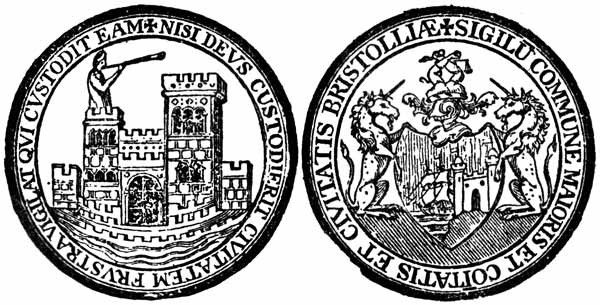
City of Bristol seal
Image from Florida Educational Technology Clearinghouse
The website this came from says that the image originally came from The Encyclopedia Britannica, New Warner [sic] Edition (New York: The Werner Company, 1893)IV:349. There is actually an online edition of this online at Google Books, unfortunately it does not date the seal, nor provide any other information about it. Looking at it, this is a mayoral seal and dates from sometime after 1569 when the city was granted its crest and supporters. It may be the seal that John Latimer in "Sixteenth Century Bristol" says was engraved by goldsmith Giles Unyt, for a payment of £4 shortly after the city was granted its new crest and supporters on its arms.
Arms
The arms of Bristol date to around the same time as the various seals and are pictured below...
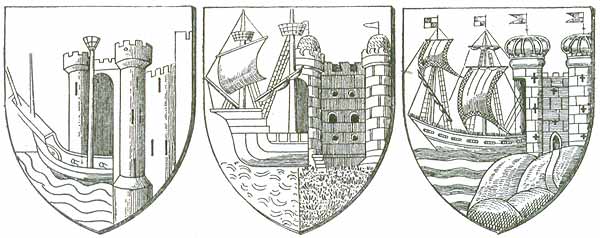
Arms of the City of Bristol
From left to right these date from the 14th, 16th and 17th centuries
Image from "John Cabot" by Marquis of Dufferin and Ava, published in Scribner's Magazine, Vol XXII, 1897
Crest and Supporters
The biggest change to Bristol's arms came on 20th August, 1569 when Bristol was granted the right add supporters, the golden unicorns, and a crest, the arms rising through the clouds holding a serpent and scales it's arms. John Latimer in "Sixteenth Century Bristol" explains how this came about.
In 1558, Queen Elizabeth I ascended the throne. Until then the annual muster of the "trained bands" had been largely ignored by Bristol, as well as most other cities. The governement started to insist that the annual muster of trained, armed men should take place and in 1561, some rusty old armour was found and dusted off. Twenty men were sent off with a quantity of gunpowder to the Gloucestershire muster with 6s 8d each for their trouble. They were not a success and their inclusion in the muster was regarded as derogatory.
The city chamberlain was dispatched to London to plead for a reaffirmation of the city's rights and privileges which was granted. A little "grease" to oil the wheels of beaurocracy had to be applied though. For example, the Earl of Pembroke who was Lord High Steward of Bristol received a butt of sack - that is, 108 gallons of sweet wine, for his inconvenience. Amongst other things, the privileges meant that Bristol would now carry out its own annual musters.
To add splendor to the muster, Latimer tells us that "12 ells of sarsanet, red, blue and yellow was purchased in London for £5 3s to make an ensign for the troops which was decorated with two buttons of gold and tassells. Sarsanet was a type of silk first imported by the Crusaders. An ell was a measure of cloth. 1 ell = 20 nails = 5 quarters (of the yard) = 45 inches. Also purchased were two drums to provide the marching beat.
The next year the muster was carried out on the Marsh in Bristol where men with new uniforms were gathered. Payment of the troops cost the city £4 16s 8d. It was at this muster where feelings began to arise that what Bristol really needed was a crest and supporters to for its arms - just like London had theirs. The new crest and supporters cost Bristol £7, and once that was granted, a further £4 for a new seal engraved by goldsmith Giles Unyt.
By 1570, the city could muster 160 men with new uniforms, equipment and guns with enough for 20 more stored in the Guildhall. The uniforms cost the city another £65 and consisted of cassocks with laced sleeves, breeches and iron corslets. This was quite a sizable force for a city of 6,000 inhabitants as Bristol then was.
John Evans in his 1824 book "A Chronological Outline of the History of Bristol and the Stranger's Guide" describes the letter of patent...
By a patent of "Robert Cooke esq, alias Clariencieux, principall and kinge of armes of the southe easte and weste partes of this realme of England from the river of Trente southewardes," the arms of the City of Bristol are declared to be "gules on a mount vert, issuant out of a castle silver upon wave, a ship golde;" and the crest and supporters now granted, "upon the heaulme in a wreathe golde and gules; issuant out of the cloudes two armes in saltour charnew, in the one hand a serpent vert, in the other a pair of balance gold; supported with two unicornes seant gold mained, horned; and clayed sables mantled gules dowbled silver." The motto, "Virtute et industria."
The full text of this letter of patent is in both "Proceedings of the Clifton Antiquarian Club for 1904 - 1908" and John Latimer's "Sixteenth Century Bristol"
To ALL AND SINGULAR AS WELL NOBLES AND GENTLEMEN and others to whom these presents shall come Robert Cooke esquire alias Clarencieux, Principall Heraulte and kinge of armes of the southe easte and weste partes of this realme of England from the river of trent southwardes sendithe humble comendacons and greeting FORASMOCHAS aunciently from the begining the valiaunt and vertuous actes of worthi persons have ben comended to the worlde with sondry monumets and remembrances of their good deserts, emongst the which the chiefest and most usuall hathe ben the bearing of signes in shildes caled armes which are evident demonstracons of prowes diversly distributed accordinge to the qualities and deserts of the persons meretinge the same to the end that suche as have done comendable service to their prince or country eyther in warre or peace may both receave due honor in their lives and also derive the same successively to their posteretie after them.
AND WHEREAS THIS CITIE OF BRISTOLL hath of long time ben incorporate by the name of mayor and comonalty as by the moste noble prince of famouse memory Kinge Edward the third and laitely confirmed by the Quenes Majestie that now is by the name and names as is aforesaid by virtue of which corporation and sithens the first grant thereof there hathe ben auncient armes incident unto the said mayor and comonaltie that is to saye, gules, on a mount vert issuant out of a castle silver, uppon wave a ship golde, YET NOT UPSTANDING, UPPON divers consideratons they have required me the said Clarencieux kinge of armes to grant to their auncient armes a creaste, withe supportars due and lawfull to be borne, WHEREUPPON, CONSIDERING their worthines and knowenge their request to be reasonable, I have by vertue of my office of Clarencieux kinge of armes confirmed given and granted unto John Stone now mayor, John Hipsley recordar, David Harris, Willm Pepwell, Robert Sayer, Roger Jones and Willm Lawe, Aldermen, Thomas Crickland and Richard Yonge sherives, Robert Halton chamberlayn and Richard Willimot towneclarke, and to their successors in lief office, this Creaste and supportars herafter followenge that is to say, uppon the heaulme on a wreathe golde and gules, issuant out of the clowdes, two armes in saltour charnew in the one hand a serpent vert, in the other a pair of balance gold, supported with two unicorns seant gold mayned horned clayed sables mantled gules doubled silver as more playnely aperth depicted in the margent, To HAVE and HOLDE THE SAID armes creaste and supportars to the said mayor and comonalty and to their successors, and they it to use beare and shew for ever more without impediment let or interuption of any persons or persons, In Witness whereof I have subscribed my hande and set hereunto the seale of my office the fower and twentithe day of August in the yere of our Lorde God A thousand five hondrethe thre score and nyne, and in the eleventh yere of the reigne of our sovereigne lady Elizebethe, by the grace of God Quene of England France and Irelande, Defendor of the Faithe, et cet "Robert Cooke Alias Clarencieux" "Roy D'armes."
Notice that the full version does not mention the city's motto "Virtute et industria." The article in "Proceedings of the Clifton Antiquarian Club for 1904 - 1908" also gives an illustration of the city of Bristol arms...
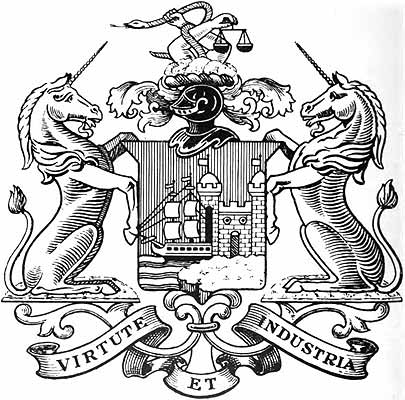
City of Bristol arms
Image from "Proceedings of the Clifton Antiquarian Club for 1904 - 1908"
The Civic Heraldry of England and Wales website also gives the heraldic description of the arms...
ARMS:
Gules on the sinister side a Castle with two towers domed all argent on each dome a Banner charged with the Cross of St. George the Castle on a Mount Vert the dexter base Water proper thereon a Ship of three masts Or the rigging Sable sailing from a port in the dexter tower her fore and main masts being visible and on each a round top of the fifth on the foremast a sail set and on the mainmast a sail furled of the second.
CREST:
On a Wreath Or and Gules issuant from Clouds two Arms embowed and interlaced in saltire proper the dexter hand holding a Serpent Vert and the sinister holding a Pair of Scales Or.
SUPPORTERS:
On either side a Unicorn sejant Or armed maned and unguled Sable.
Here's a short, simple glossary of what some of these heraldic terms mean. For fuller explanations see sites like A glossary of Terms used in Heraldry.
argent - silver or white
armed - horned and hoofed
dexter - right
gules - red
or - gold
sable - black
saltire - crossed
saltour charnew - crossed and natural in colour (of the arms holding the serpent and scales)
seant or sejant - sitting
sinister - left
unguled - of a hoofed animal where the hoofs are different color from the body
vert - green
Symbolism
The various elements that make up the arms mean something. The oldest part, the ship and castle, are pretty obvious.. other elements not so much. The unicorns will only do homage to men of virtue, hence the unicorns are seant (seated) rather than rampant (rearing up on their hind legs). The arms in the crest signify that good government depends on wisdom (the serpent) and justice (the scales) and that these are divine gifts from above - which is why the arms are rising out of a cloud.
I've not found an explanation, or even a hint, of why the crest includes a helm. A search of internet heraldry websites does give a rough idea though. When included on arms the helm is placed above the shield and supports the crest. It does not always signify any particular achievement in armed conflict but the style does depend on the social rank of the bearer. Open helms were reserved for the nobility whilst closed helms, like that on the city's arms, were used for the commonality.
This page created 6th November 2009, last modified 11th November 2009